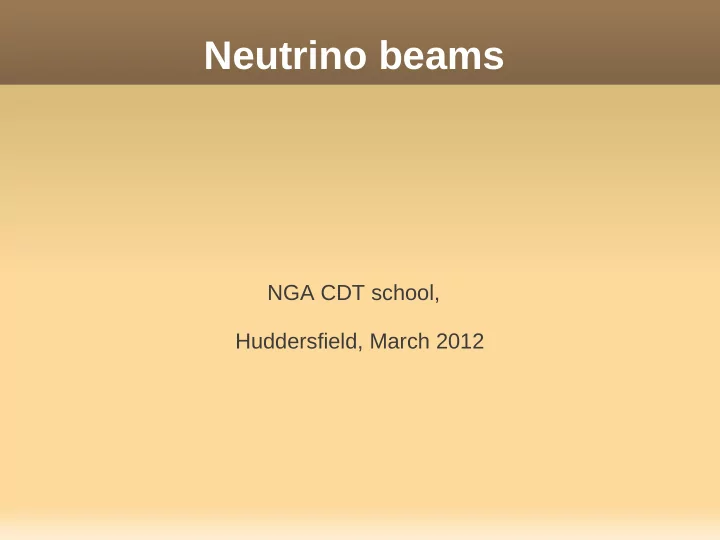

Neutrino beams NGA CDT school, Huddersfield, March 2012
Main neutrinos sources Nuclear fusion in the Sun: 4 1 H → 4 He + 2e + + 2 ν e + 3 γ, or ● 4 1 H → 4 He + 2e + + 2ν e + 26.7 MeV ● Cosmic rays colliding in Earth atmosphere - process is similar to that used to produce neutrino beams from particle accelerators Nuclear reactions - fission reactors produce anti ν e from beta decays of fission fragments Particle Accelerators - produce V μ (or anti V μ ) from pions decay in flight
Accelerator neutrinos ● method is conceptually identical to that described by Fred Reines in 1960 ● Lederman, Schwartz and Steinberger (1962 experiment - Nobel Prize) ● all currently available neutrino beams generated in this way ● nearly pure beam of muon neutrinos (or muon anti neutrinos) ● contamination with electron neutrinos → near detector and far detector used ● neutrino energy spectrum calculated from beam parameters (broad) ● off axis beam at the far detector → smaller energy spread
CNGS V μ sent from CERN to Gran Sasso National Laboratory (LNGS) Look for muon neutrinos into tau neutrino conversion - p beam from Super Proton Synchrotron (SPS) E p = 400 GeV - decay in the 1 km tunnel - OPERA and ICARUS detector search for tau neutrinos
MINOS MINOS (Main Injector Neutrino Oscillation Search) Designed to make the most precise measurement of Δ m 2 23 and sin 2 2 θ 23 (search for V μ disappearance in beamline) Variable beam energy, short pulses ~10 μ s, ~10 13 p Magnetic horns Absorbers: stop the hadrons that have not decayed 240 m of rock range out any muons produced 2 detectors 735 km apart: - Near detector → neutrino spectrum - Far detector → evidence of oscillation ● Data collection from 2005 through 2014 ●
Neutrino Oscillation Signal MINOS measured ν μ disappearance ( ν μ → ν τ ), but ν e appearance ( ν μ → ν e ) has not been observed → T2K Experiment (Japan)
T2K – (1) Goal: search for oscillations from ν μ to ν e and determine the value of θ 13 First off axis neutrino experiment J-PARC facility (Japan Proton Accelerator Research Complex) is a high intensity proton accelerator facility: E p = 50 GeV E v = 600MeV (likely to oscillate after 300 km) Off axis detectors ( at 2.5 degrees with respect to the neutrino beam): ND280, SuperKamiokande
T2K – (2) Most neutrinos pass through detectors without interacting SuperKamiokande: 11,000 photo- multipliers to detect Cerenkov radiation as a ring Muons produce a sharp ring; electrons produce a diffuse ring. T2K announced the first-ever experimental evidence for ν μ to ν e oscillations in June 2011.
Future Neutrino Sources Neutrino Factories (1) The ultimate accelerator-derived neutrino source; Uses decay of muons stored in a particle accelerator μ + → e + + ν e + anti-ν μ or μ - → e - + anti-ν e + ν μ ● Neutrino spectra can be calculated with great precision; ● this is an extremely simple and well-understood decay → powerful and ● elegant technique; Technical problem→μ lifetime = 2.2 microseconds: Muons have to be produced, accelerated and stored within a very small ● fraction of a second; Theoretical studies show that neutrino factories have the greatest potential for increasing our understanding of neutrinos, so this technical challenge is being addressed;
Neutrino Factories (RAL) H - produced by a thermionic emission source -> (linac)-> rapid-cycling synchrotrons (RCS) Ions striped by e - ->p The proton driver needs to take account of target limitations (shock, heating) in its choice of energy and the length and structure of the bunch train. The driver energy and target geometry determine the pion/muon distribution. The need is to maximise the number of muons entering the accelerating system
Neutrino Factories (2) abc
Neutrino Factories' Muon FFAG Muon FFAG requirements 20 – 50 GeV ● ultra-relativistic Large acceptance ● Quick acceleration ● Muon’s lifetime at rest is 2.2 μs. Electron Model of Muon Accelerator
Neutrino Factories (3) a possible future facility for creating very intense beams of neutrinos to make detailed studies of the phenomenon of neutrino oscillations. a potential successor to the T2K experiment and a possible future facility for the Rutherford Appleton Laboratory, Oxfordshire. consist of a number of different accelerators and most of these are beyond the state of the art. This has led to the creation of several R&D projects to understand how these can be built, for example MICE, studies of pion production targets, and EMMA.
Recommend
More recommend